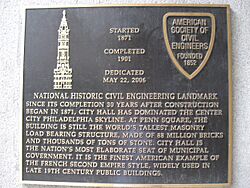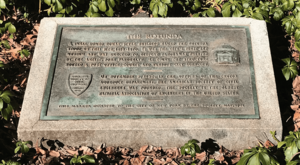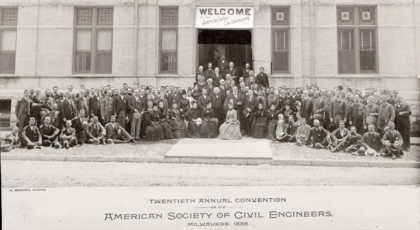American Society of Civil Engineers facts for kids
 |
|
| Abbreviation | ASCE |
|---|---|
| Founded | November 5, 1852 |
| Type | Engineering society |
| Focus | To help advance the science and work of Civil engineering and to improve people's lives through the work of its members. |
| Location |
|
|
Area served
|
Worldwide |
| Method | Industry standards, conferences, publications |
|
Members
|
143,189 (2021 ASCE Official Register) |
|
Official language
|
English |
|
President
|
Feniosky Peña-Mora, Sc.D., P.E. (2025) |
|
Past President
|
Marsia Geldert-Murphey, P.E. (2024) |
|
President-elect
|
Marsha Anderson Bomar, Ph.D. (2026) |
|
Secretary and Executive Director
|
Thomas W. Smith III |
|
Revenue
|
US $49.4 million (2022) |
| Endowment | US $29.2 million (2022) |
|
Employees
|
250 |
The American Society of Civil Engineers (ASCE) is a group for civil engineers from all over the world. It was founded in 1852, making it the oldest national engineering society in the United States. Its main office is in Reston, Virginia.
Civil engineers are the people who design and build amazing things that help us every day, like bridges, roads, dams, and skyscrapers. The ASCE was created to help these engineers share ideas, learn new skills, and use their work to make life better for everyone. Today, the society has over 143,000 members in 177 countries.
Contents
History of the Society
Early Attempts to Organize
In the early 1800s, engineers in the United States wanted to create a professional group, just like the one that had started in Great Britain. An early attempt was made in 1838 to form an "Institution of American Civil Engineers." A group of 40 engineers met in Baltimore, Maryland, to get it started.
Some of the famous engineers involved were Benjamin Wright, who is known as the "Father of American Civil Engineering," and J. Edgar Thomson, who would later become president of the Pennsylvania Railroad. They wrote a constitution for the group, but it was hard for members to travel to meetings back then, and the plan fell apart.
A Society is Born
In the 1840s, many new professional groups were forming in America. Finally, on November 5, 1852, a group of engineers led by Alfred W. Craven met in New York City. They successfully started the "American Society of Civil Engineers and Architects." James Laurie was chosen as the first president.
The group stopped meeting for a while because of the American Civil War. But in 1867, twelve years later, the members came back together, determined to keep the society going. A year later, in 1868, they changed the name to the American Society of Civil Engineers, which is still its name today.
A Groundbreaking Woman in Engineering
In 1905, Nora Stanton Barney became one of the first women in the U.S. to get a degree in civil engineering. That same year, she became the first female member of ASCE. At the time, she was only allowed to be a junior member. In 1916, she was not allowed to become a full member because she was a woman.
However, the ASCE later recognized its mistake. In 2015, long after she had passed away, the society honored her by making her an ASCE Fellow, one of its highest honors.
Great Engineering Achievements
In 1999, to celebrate the end of the 20th century, the ASCE chose the top ten civil engineering achievements. These were projects that had a huge positive impact on people's lives. They called them the "Monuments of the Millennium."
Here are some of the amazing achievements they picked:
- Dams: The Hoover Dam, which controls the Colorado River and provides power to millions.
- Long Bridges: The famous Golden Gate Bridge in San Francisco, California.
- Rail Travel: The Eurotunnel, a tunnel under the sea that connects the United Kingdom and France.
- Skyscrapers: The Empire State Building in New York City, one of the world's most iconic tall buildings.
- Water Travel: The Panama Canal, a man-made waterway that allows ships to travel between the Atlantic and Pacific oceans.
- Highways: The Interstate Highway System in the United States, which connects the entire country.
- Water Supply: The California State Water Project, which brings water to millions of people in California.
What Does ASCE Do Today?
Sharing Knowledge and Learning
A major goal of ASCE is to share information with engineers. The society publishes 35 different journals, which are like magazines full of the latest research and ideas. It also publishes books, standards for building things safely, and a monthly magazine called Civil Engineering.
ASCE also holds conferences and meetings where engineers can learn from each other. Every year, thousands of engineers attend these events to stay up-to-date on the newest technology and best practices in their field.
Special Groups for Engineers
Civil engineering is a very broad field. To help engineers focus on their specific area of work, ASCE has nine special groups called Institutes. Each one is for a different type of engineering.
Some of the Institutes include:
- Structural Engineering Institute (SEI): For engineers who design buildings, bridges, and other structures.
- Environmental and Water Resources Institute (EWRI): For engineers who work with clean water and protecting the environment.
- Transportation and Development Institute (T&DI): For engineers who design roads, airports, and other transportation systems.
- Construction Institute (CI): For engineers who manage the building of large projects.
Speaking Up for Better Infrastructure
ASCE also works to improve the world around us. The society talks to government leaders about the need for safe and modern infrastructure (the basic systems a country needs, like roads, bridges, and clean water systems).
They encourage governments to invest in fixing old infrastructure and building new, sustainable projects. They also support programs that get kids and students excited about science, technology, engineering, and math (STEM).
Awards and Honors

ASCE gives out many awards to celebrate amazing engineers and projects. The Outstanding Civil Engineering Achievement (OCEA) award is given each year to a project that shows incredible engineering skill.
Other important awards include the Norman Medal, which is the society's oldest award, and the Walter L. Huber Civil Engineering Research Prize, which is given to younger engineers who are doing important research. These awards help recognize the hard work and creativity of civil engineers.
The ASCE Foundation
The ASCE Foundation is the charitable part of the society. It was started in 1994 to raise money for programs that support engineering education and projects that help communities. The Foundation helps prepare the next generation of civil engineers and promotes the use of engineering to improve life for people everywhere.
See also
 In Spanish: Sociedad Estadounidense de Ingenieros Civiles para niños
In Spanish: Sociedad Estadounidense de Ingenieros Civiles para niños
- ASCE Library – online database of civil engineering journals, proceedings, e-books, and standards published by the society
- List of Historic Civil Engineering Landmarks – landmarks designated by the ASCE





